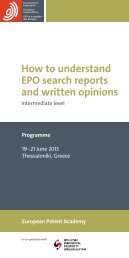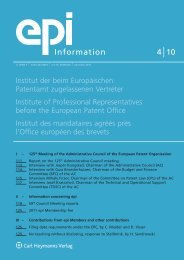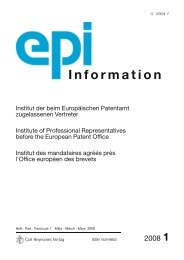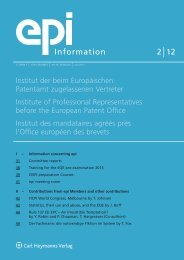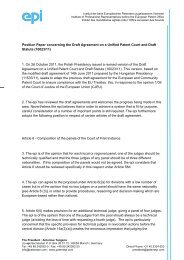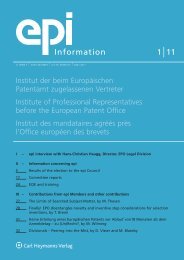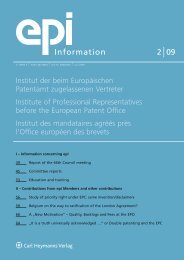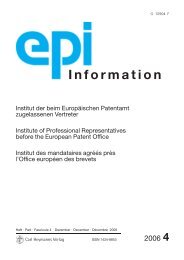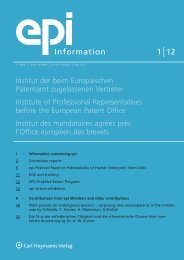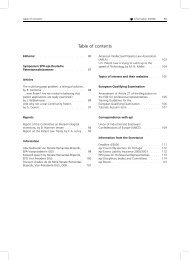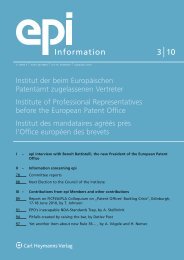4 10 Information - European Patent Institute
4 10 Information - European Patent Institute
4 10 Information - European Patent Institute
You also want an ePaper? Increase the reach of your titles
YUMPU automatically turns print PDFs into web optimized ePapers that Google loves.
130 Articles <strong>Information</strong> 4/20<strong>10</strong><br />
disclosure is that in the latter case the skilled person<br />
already knows the contents of the patent application in<br />
question, whereas in the first case such content is<br />
unknown to him 5 . The closest prior art and the technical<br />
problem to be solved therefore are of no relevance when<br />
pondering sufficiency of disclosure. In addition, the solution<br />
provided by the invention may be taken from a<br />
different technical field compared to the field of the<br />
closest prior art (as analysed with respect to inventiveness).<br />
For this reason, the skilled person constructed in<br />
the process of deciding on inventiveness may have a very<br />
different common technical knowledge compared to the<br />
skilled person in the field the invention is taken from 6 .<br />
Moreover, industry standards being day-to-day business<br />
of the first skilled person may be unknown to or not<br />
sufficiently comprehended by the second skilled person.<br />
Thus, the mere label „industry standard“ does not entail<br />
a guarantee that a technical teaching is sufficiently disclosed<br />
according to the relevant skilled person’s judgement.<br />
The Boards of Appeal would still have to consider if<br />
the specifications provided by a standard are sufficient to<br />
enable the skilled person to carry out an invention. Even if<br />
products according to a standard had been available on<br />
the market for a long time before the relevant date of the<br />
patent application, this cannot be as such indicative that<br />
the average skilled person would be able to transfer any<br />
prior knowledge to the special circumstances of an<br />
invention. It should not be forgotten that by its very<br />
definition an invention surpasses the average skilled<br />
person’s abilities. Concluding, sufficiency of disclosure<br />
has to be decided on a case by case basis even if<br />
applicants claim that by reference to an industry standard<br />
the invention has been sufficiently disclosed.<br />
3.3. Another requirement imposed by Art. 83/<strong>10</strong>0 b<br />
EPC is that it is forbidden to impose an „undue burden“<br />
on the skilled person when trying to carry out the<br />
invention. The degree of detail required by a patent<br />
application or patent document, respectively, to avoid<br />
undue burden has to be judged in view of the invention<br />
in question. A rough outline of an invention may be<br />
sufficient in one case, e.g. when a problem can surprisingly<br />
be solved by means already familiar to the skilled<br />
person in some other context, whereas a plethora of<br />
examples and instructions may be required in other<br />
cases, e.g. where the standard merely consists of a<br />
compilation of requirements, leaving it to the skilled<br />
person to develop by himself means for living up to these<br />
requirements in the frame of the invention in question.<br />
Again, just referring to an „industry standard“ may or<br />
may not provide the skilled artisan with enough<br />
information to carry out the invention.<br />
5 cf. also T 694/92, section 7<br />
6 The thesis that the standard for the skilled person’s knowledge is generally<br />
the same for the requirements of inventive step and sufficiency of disclosure<br />
is thus untenable. The mistake seems to result from a translation error<br />
concerning decision T 60/89, section 3.2.5, which unfortunately has also<br />
crept into the German version of the „Caselaw book“. The Board held – in<br />
the language of the proceedings – that the same level of skill has to be<br />
applied when, for the same invention, the two questions of sufficient<br />
disclosure and inventive step have to be considered. This was erroneously<br />
translated into „der gleiche Wissensstand“, i. e. the same knowledge.<br />
But even disregarding difficulties in understanding the<br />
specifications of an „industry standard“, undue burden<br />
may also be imposed circumstantially. This is an important<br />
difference when comparing state of the art-related<br />
obstacles to patenting like novelty and inventive step<br />
with the requirement of sufficient disclosure. Even grave<br />
difficulties of finding and accessing a document are of no<br />
interest for qualifying a document as prior art 7 . Contrary<br />
to this, such difficulties may result in the very same<br />
document being left out of consideration when pondering<br />
sufficiency of disclosure. The inventor shall not be<br />
rewarded for cunningly hiding key teachings of the<br />
invention in documents unduly difficult (or costly 8 )to<br />
obtain, as such behaviour would again not be commensurate<br />
to the scope and ease of protection granted by a<br />
patent. Otherwise the inventor could profit twice: He<br />
would own a patent, and he could make a fortune by<br />
selling the necessary instructions to carry out the invention.<br />
If such sales were made under a non-disclosure<br />
agreement, he could even continue to sell the instructions<br />
long after the patent itself has expired. As Stellbrink<br />
correctly points out, once the level of detail of such<br />
instructions is sufficient, these instructions could not be<br />
developed a second time by another party without any<br />
criminal offence.<br />
It may be surprising that mere formalities like the<br />
mode of access to information could influence the<br />
decision on enabling disclosure 9 . However, it should be<br />
remembered that Art. 83/<strong>10</strong>0 b EPC stipulates that the<br />
invention should be disclosed clearly and completely in<br />
the application or patent document, and anything relied<br />
upon other than the literal content of the application<br />
documents or patent document needs justification to be<br />
taken into consideration. It would therefore be up to the<br />
advocates defending the righteousness of relying on<br />
standards subject to non-disclosure agreements and<br />
subject to the need for obtaining a licence to show<br />
convincingly how the intention underlying the EPC could<br />
be achieved, which is that all inventions shall become<br />
free art in their entirety („clear and complete“) once the<br />
corresponding patents lapse. In particular, the Boards of<br />
Appeal may consider that requiring the skilled person to<br />
obtain a license before disclosing the invention clearly<br />
and/or completely to him generally puts him under a<br />
persistent obligation <strong>10</strong> to pay royalties, to grant third<br />
party accounting experts access to his business records,<br />
and maybe even to abstain from invalidating patents<br />
held by the licensor or other licensees. Such obligations<br />
may be considered an undue burden for a skilled person<br />
7 T 165/96, section 1.1.1.4<br />
8 This was deliberately left undecided in T 82/07, section 6.5. Decisions<br />
T 50/02 and T <strong>10</strong>30/00 do not seem to be applicable, as they are only<br />
concerned with the question of whether or not a document belongs to the<br />
state of the art. Stellbrink himself argues (correctly) that „state of the art“ is<br />
not a subject of Art. 83 EPC.<br />
9 It is important to note that decision T 50/02 does not stand in the way of such<br />
considerations. That decision was concerned with defining the prior art; it did<br />
not attempt to abolish the established bar against undue burden with<br />
regards to enabling disclosure.<br />
<strong>10</strong> This is clearly different from other industry standards, e.g. those proclaimed<br />
by ISO or DIN. Even though such standard specifications also can only be<br />
obtained from one or few sources, any person interested in such standard<br />
merely has to buy a copy thereof.



